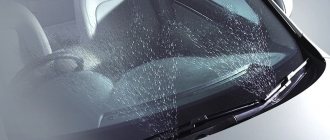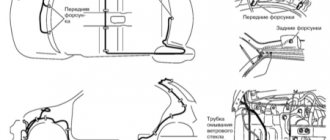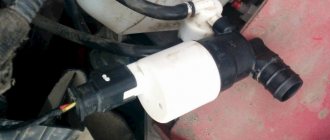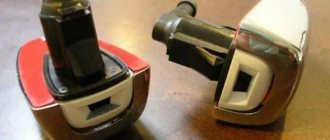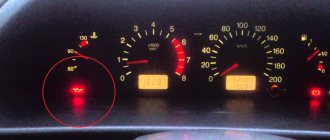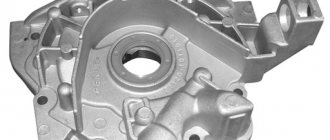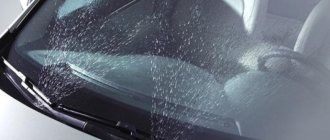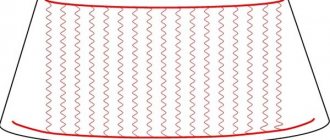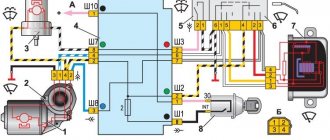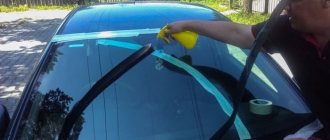Mechanism
The mechanism, as mentioned above, consists of several elements. Let's take a closer look at each of the elements:
Tank
The washer reservoir is attached to the left side of the car in the engine compartment. Made of translucent plastic. Quite often, this element fails because it bursts at the attachment points and begins to leak liquid.
- The volume of the washer reservoir is 2.5 liters.
- Cost from 200 to 500 rubles.
Motor (pump)
The pump is an electric motor with an impeller that pumps water into the main line. In Priors with hatchback and station wagon bodies, two motors are installed, for the front and rear window washers. The most frequently damaged element.
- The cost is up to 150 rubles for a Chinese pump, and up to 300 rubles for a Russian one.
Highway
The line consists of tubes going from the motor to the injectors. It happens that over time the tubes burst and the glass cleaning liquid does not reach the nozzle and is lost somewhere in the engine compartment.
- Cost up to 100 rubles
Injectors
The nozzles are installed on the hood of the car and spray liquid onto the windshield.
- Cost up to 100 rubles per pair.
Operating principle of the device
So, an electric pump is currently being installed; previously it was a mechanical one. We also have a tank in which the glass spray liquid is stored. Naturally, there are two tubes through which it flows to two sprayers. The volume of the tank can be 2.5-5 liters, which is quite enough for a long period of operation, due to the efficiency of the injectors. The electric pump located in the reservoir is activated by the steering column switch. This way, cleaning liquid is supplied to the windshield and the wipers turn on for a while.
Ordinary water is used as a working fluid - this applies to the summer period, but in winter, when it is cold, a special “anti-freeze” is added there. Two types of nozzles are used: jet and fan. It’s difficult to say which is better, both of them give excellent results. That’s probably all that concerns the device and operating principle of the washer.
Replacing the motor
Replacing the washer pump on a Lada Priora is quite simple, using the instructions below.
The first thing you need to do is prepare the necessary tool:
- Ratchet with 10mm and 13mm heads
- Open-end wrench 10mm
Process
For convenience, we remove the battery, this will make replacement work more convenient.
- We unscrew the battery mount, then its seals and remove the battery.
- We remove the chips from the washer motor (in this case there are two of them).
- To diagnose the washer reservoir, it must be removed, and it is much more convenient to replace it with a removed reservoir. To do this, unscrew the two nuts securing the tank.
Removing the barrel
To remove the windshield washer barrel, you will need:
- First of all, disconnect the negative terminal from the battery.
- Disconnect the block from the sensor that measures the liquid level.
- Disconnect the connectors from the electric pump motor. When reassembling the VAZ 2110 windshield washer, you should remember: the positive terminal has a pink wire, the negative terminal has a black wire.
- To empty the barrel, you need to open the lid and take out a cup with a mesh.
- Unscrew the bolt from the fastening nut, not forgetting about the washer installed under the bolt head.
- Then you need to lift the tank and remove it from the studs.
- If there is windshield washer fluid left in the barrel, then to remove it, you need to cover the hole and disconnect the hose from the fitting. The drained auto fluid can be safely used in the future, and therefore it is worth using clean dishes for its temporary storage.
Replacing the Priora windshield washer motor
Before replacing the washer reservoir electric motor pump on a Lada Priora, you need to check it. First of all, check the fuse responsible for this power circuit, if it is working, check the wiring and only then, if the above two points do not pass, check the pump itself. Prepare a standard set of tools and perform the following sequence of actions:
- First of all, you need to remove the battery, as it will interfere with further work.
- Disconnect the block with the power wires from the pump and connect the power source directly to its terminals by connecting two wires from the battery. If the pump does not work, then it must be replaced with a new one, since it cannot be repaired. If the pump starts working, then the problem must be looked for further in the electrical wiring of the car.
Cause of failure due to electrical
Electrical causes may be:
- The fuse may have blown. It is located in the fuse box;
- Check the leads that are equipped with the VAZ 2110 washer motor; it is quite possible that they have oxidized. It happens that the terminals completely fall off;
- The windshield washer switch located on the steering wheel does not work. Its performance can be easily checked with a multimeter;
- Wiring faulty. The wires may need to be replaced;
- The windshield washer relay does not work. The best treatment is also replacement.
You can read about the reasons why wipers fail in this material:
DIY windshield washer motor replacement
To ensure sufficient visibility when driving in bad weather, your vehicle's windshield wipers and washer system must function properly. The windshield washer pump delivers a stream of water that helps remove dirt that has accumulated on the glass. At first glance it seems that this detail is not very important. But when it rains, you will practically not be able to continue driving if the pump fails.
Why is it needed?
What does a driver do if a layer of dust or some kind of dirt suddenly contaminates the windshield on the street? That's right, he presses a special lever under the steering wheel of his VAZ 2110, turns on the washer pump, which, in turn, interacts with the wipers and removes all this debris . What if the pump fails? Then there are two options:
- Drive further, do not stop, looking through the dirty windshield, or even look at the road, leaning out through the side window;
- Stop, wipe the windshield by hand and continue driving.
The second option is more attractive. But this is a temporary measure that will allow you to get to the garage where you can repair your washer.
Washer pump
How does a windshield washer motor work?
The motor in the windshield washer allows a stream of water or windshield cleaning liquid to be supplied under pressure. In some models, the jet is supplied not only to the front, but also to the rear window. It is not difficult to set up the operation of windshield washer parts, but when the motor breaks down, most car owners contact the service center to replace it. In fact, repairing a motor is quite easy, the main thing is to know a few secrets.
External view of the windshield washer motor
How to disassemble the washer motor of a VAZ 2110
Repairing the windshield washer motor (or rear window, or headlight washer) is quite possible, but many drivers are forced to buy a new motor, which costs more than two thousand on some foreign cars.
In addition, replacing a new motor at some auto repair shop can cost about a thousand rubles. In this article, we will look in detail at how to restore the normal operation of a windshield washer motor or a headlight washer motor with our own hands - the operating principle and device are almost the same, and therefore the malfunctions are also the same. If the washer system, both windows and headlights, fails, driving, of course, becomes uncomfortable and unsafe, and since in most regions wet and slushy weather occurs almost throughout the year, using a cloth and a bottle of water becomes quite tiresome, yes and this is undignified, especially if the car is not cheap.
Of course, for some inexpensive foreign cars and domestic cars, the washer motor is not expensive and it is easier to replace it with a new one than to tinker with the old one, but for some imported cars of reputable brands, spare parts are still quite expensive. Therefore, it makes sense to restore the glass washer of such cars on your own, and the repair may take quite a bit of time. And we’ll talk below about how to make it at home.
Malfunctions of the glass or headlight washer.
The main malfunction that subsequently causes a glass washer or headlight washer to stop working is the wear of the rubber seal, which sits on the electric motor shaft and separates the electric motor itself from the part of the washer in which the impeller is located and the liquid for spraying the glass is constantly present (or circulating). When the oil seal wears out, liquid begins to seep between it and the shaft and enters the cavity of the electric motor, as well as onto the bushings and armature shaft.
As a result, corrosion appears on the electric motor shaft and its bushings (and not only), from which the motor armature shaft jams (especially when the washer is not used for several days) and the motor stops working. Getting rid of such a malfunction is not at all difficult, but for this, as surgeons say, an autopsy will be required.
You can, of course, simply develop the shaft by removing the impeller from the shaft and rotating it manually, but this will not last long and it is better to disassemble everything, clean it, restore the mobility of the motor armature shaft and then lubricate the bushings and reassemble the pump.
Most windshield washer pumps are made to be non-dismountable, and the plastic housing is sealed at the factory. But you can open the case using a hacksaw blade for metal, if you carefully walk it in a circle in the area of the step of the case. Why in the area of the steps, and not in the middle of the building? Because the step on the body will allow you to make a straight cut, focusing on it, and during further assembly it will be more convenient to solder (or glue) the body in the area of the step.
Having cut the washer body, carefully separate its halves using a screwdriver (or knife) - see photo 1, after separating the plastic body, you need to remove the stator (see photo 2 below) and carefully remove the armature (or rather its collector) from it motor brushes without bending the brush plates. The disassembled pump is shown in photo 2 below.
Next, we remove corrosion from the cavity of the electric motor, but we especially carefully clean (to a shine) the armature roller in the area of its friction in the bushings - see photos 3 and 4 below, and we also clean the bushings themselves from oxides with fine sandpaper. After cleaning, we check the free rotation of the electric motor armature in the stator (housing) bushings.
Washer failures, their causes and diagnosis
Most often, the cessation of fluid supply is due to clogged filters. Therefore, first of all, clean the system and eliminate the cause of the breakdown - contamination . If it turns out that the motor has stopped working, then you will need to clean its parts from rust and dust. Replacing the mechanism will only be necessary as a last resort. In some situations, electrical breakdowns occur. This is due to loss of contact on one of the connections. With frequent temperature changes, over time, the motor terminals oxidize, which leads to their complete or partial destruction. Most often, breakdown occurs due to:
- clogged washer nozzles;
- a broken hose;
- fluid leaks;
- washer switch malfunction;
- Damage to motor terminals.
Tip: First, inspect the windshield washer reservoir and clean the system of dirt, and only after that proceed to cleaning the motor.
Step-by-step replacement instructions
Despite the fact that different car models have distinctive windshield washer design features, the diagnostic and replacement process is similar. The repair will not take you much time. New components, if needed, are inexpensive and will cost you about 500 rubles. The tools you will need are a flathead and Phillips screwdriver and a set of standard wrenches.
- Using the technical manual for your model, we find the exact location of the tank and motor.
- Turn off the power supply. To do this, disconnect the wires that go to the pump.
Disconnect the wires that supply the windshield washer pump
Remove the tank after disconnecting the hose and fitting
Disconnect the windshield washer pump and clean it
When disassembling the pump, it may be discovered that the bushing has become unusable and needs to be replaced. Such a part is inexpensive and when repairing it is better to purchase it in advance to increase the service life of the mechanism.
How to replace (video tips)
If problems arise with the windshield washer, do not delay repairs. In bad weather, you cannot do without cleaning the windshield, and low visibility often leads to emergency situations on the road. Replacing the motor or cleaning it can be done on your own, it will take very little time.
Device failure due to mechanical reasons
Typically, the root cause of a 2112 windshield washer failure can be either mechanical or electrical. Sometimes problems can be recognized by sound, or identified by carrying out a simple test.
- It is possible that the glass with the mesh is clogged with dirt or other deposits, as a result of which the pump can no longer pump car fluid. Having removed the tank, you can easily determine what should be done: replace the glass with a mesh or simply rinse it.
- Having decided to save money, during the hot period they did not use anti-freeze, but filled the car with plain water. But then the cold weather arrived, and the water was not removed from the hoses. And water, as you know, tends to freeze. The pump simply cannot cope with such a problem. In this case, even the fact that an anti-freeze agent was added in the winter will not help. What to do? Warming up and placing the car in a warm garage can solve the problem, you just have to wait until the water in the hoses begins to melt, then the pump can pump it out and remove it.
- In addition to the situation described above, due to heavy loads, the windshield washer motor shaft is often damaged . Such a breakdown can be determined by ear - the motor seems to be working, but the pump does not pump anything. If this breakdown occurs, the entire mechanism will need to be replaced.
- The hose may come off, and the auto fluid flows out somewhere past the injectors. Everything is simple here - just fix it, and everything will work.
- The hose that goes through the injectors may be pinched. Here you need to look at the situation, you may have to order a replacement.
- Dirt and sediment are clogged in the spray nozzles. How can I check this? It's very simple - remove the hose and see if liquid flows through it. Only replacing the nozzles can help here.
The windshield washer motor does not work: where is it located and what to do
Hi all! The problem of windshield wiper failure is familiar to many. One of the reasons may be the pump pumping water to the system. So today they propose to discuss the windshield washer motor.
Externally, the element is quite small, but plays a vital role in the operation of injectors and wipers. In fact, without it, water will not be able to get from the tank onto the windows, and the wipers will simply begin to crawl across the dry windshield, scratching the surface with settled dust or dirt. There's nothing good here.
What does the washer consist of?
This element of the car is quite simple in design and consists of:
- tank;
- pump with motor;
- hose;
- nozzles;
- washer fluid level sensor.
As you can see, nothing overly complicated, however, even here malfunctions occur. Read our article about the reasons for this and how to neutralize them without contacting a service center.
Damage to the washer can be mechanical or electrical. The former are much more common than the latter.
Device Features
There are new and old motors. The latter can be found on Soviet cars, or on VAZ 2107, 2108, for example.
Most cars, including the VAZ 2109, 2110, 2114, as well as foreign cars Mitsubishi Lancer, Pajero Sport or Ford Focus, already use new types of washer motors (pumps).
The main components of the washer are:
- nozzles;
- pump (motor);
- reservoir with washer fluid.
Nozzles are used to supply water to the windshield of a car. Therefore, they should be positioned so that the outgoing stream of liquid hits the center of the headplate as much as possible. The pump supplies water to the tank. By the way, on some cars, wash water is supplied not only to the windshield, but also to the main headlights in front and behind.
It doesn't matter what kind of car you have. It could be a Priora, a Hyundai Accent, some Mazda or Toyota. All the washer motors work on the same principle. Although the device, characteristics and appearance may vary.
Pumps supply water or washer fluid. If the windshield washer does not work, most likely the reservoir or the nozzles themselves are broken. They can be replaced or repaired yourself.
If the pump breaks, the task is a little more difficult. It is important to immediately identify the problem and fix the breakdown. Driving a car, especially in bad weather, when the windshield wiper does not work, is dangerous.
Causes of malfunctions
Don't rush to blame the engine for everything. It may work, but the windshield wiper does not function for other reasons.
Let's look at the key reasons why our wipers stop doing their job.
- Clogged filter or nozzle. Frequent breakdown. Especially for those who use tap water instead of special washer fluid. To solve the problem, you need to dismantle the devices and flush the system. The work is not difficult, but delicate;
- Supply hoses. They wear out over time, lose their tightness, and burst. Everything is simple here. Remove the old hoses and install new ones. Their price is cheap even on foreign cars;
- Incorrect connection. While carrying out some repair work on the wipers themselves or nearby components, you could disassemble the washer system and reassemble it incorrectly. Check connections and correct errors made during assembly;
- Electric motor and pump shaft. It happens that the connection between them is weak or completely broken. What to do? Right. The element needs to be better secured;
- Motor failure. It doesn’t happen that often, but you shouldn’t rule out this option. Before changing a part, try to clean the motor and its brushes, and get rid of all traces of corrosion. Sometimes it helps. If the repair does not produce results, replacement will help.
Here are the main causes of windshield wiper failure. It is not the most complex mechanism in a car, so you can repair it yourself.
Main problems
All existing faults with the front washer can be divided into two main types, which have their own sub-problems, so to speak. We invite you to familiarize yourself with them in the table.
| Fault type | Failure options |
| Mechanical problems | The washer fluid reservoir is empty |
| The hose fell off the pump | |
| The injectors are clogged | |
| Electrical faults | Fuse burned out |
| The clamps have oxidized | |
| The switch is broken |
But each of these faults deserves a more detailed consideration.
Mechanical breakdowns
It is with mechanical washer malfunctions that owners of the VAZ 2110 most often encounter. This is compared with the regularity of electrical problems.
- The washer fluid tank is empty. Inexperienced drivers often start blaming a faulty pump, although in practice they simply forget to check the antifreeze level in the tank. Hence the unjustified costs for the services of service stations. Don’t forget to check the fluid level, and in winter, be sure to drain the regular washer fluid and fill it with anti-freeze in its place. Ordinary water at subzero temperatures will turn into ice, and therefore will not be able to take part in cleaning the windshield. If you still forget to drain and the water freezes, warm up the car for a while so that the ice melts, then drain and fill with a suitable liquid.
- The hose fell off. Anti-freeze is supplied from the tank to the windshield using a pump and special hoses. If these same hoses begin to jump out of their places, the liquid will not be able to flow to the nozzles. As a result, the washer does not function. Try to secure them better. And if they are worn out, simply replace the old hoses with new ones. If the mounting is normal, water may still not flow to the nozzles. In this case, check whether the hoses are pinched.
- The injectors are clogged. The anti-freeze agent, supplied by a pump and passing through hoses, then exits onto the windshield using nozzles. These are the same small devices from which streams of water come. If they are dirty, disconnect the hoses from the injectors and check their condition. Often the problem lies in the jets. They are easy to clean, but in some situations they may need to be replaced.
Pump and reservoir
Electrical breakdowns
Although mechanical failures are more common, electrical problems should not be forgotten.
- The fuse has blown. If, when you turn on the device for cleaning the windshield, the pump does not show signs of functioning, there is a fairly high probability that the cause is a failed fuse. Check its condition. If the device really burns out, you can simply replace it with a new one.
- The switch does not work. If the pump stops working, but the fuse is intact, then the problem may be a faulty steering column switch. To check this, do a little system testing. But for this you will need an assistant. Turn on the ignition and ask a friend to turn on the washer. In this case, go to the pump yourself and check for voltage in it. If there is voltage but no functionality, you will have to change the motor, that is, the pump. If there is no voltage, then the culprit is a switch, relay or wiring. Check everything. Replace what is necessary.
- The clamps have oxidized. Be sure to check the condition of the pump terminals. It’s not uncommon for wiring to oxidize due to moisture and literally fall apart over time. If this happens to your washer, try to properly replace the damaged wiring.
Replacement
If the old motor has failed, there is no point in trying to repair it somehow. To buy a new part, you will have to spend very little money. And the replacement procedure on most cars is extremely simple.
I will describe the main stages of work associated with replacing this element of the windshield cleaning system of any car.
- Turning off the vehicle's power. A safety measure without which further work makes no sense. Be sure to remove the negative terminal from the car. It's simple but important. Otherwise, you not only risk burning the wiring, but also getting an unpleasant electric shock yourself.
- Search for a motor. It all starts with identifying where your windshield wiper motor is located. It depends on your car. On some cars, just lift the hood and you will immediately see the washer reservoir. The motor itself is located on the reservoir (partially inside) of the windshield wiper, into which the liquid is poured. Do you see the tank? If yes, then you are in luck. If not, then you will have to look for it by removing elements of the engine compartment. On some car models, the tank is hidden so that the fender protection has to be removed.
- Disconnect the connectors with wires from the motor. Then remove the tank itself.
- The hose and fitting are separated from each other. Don't forget to drain the liquid. Filling a new one will not be difficult. Yes, and for prevention it won’t hurt to do it.
- Using a screwdriver, push the intake seal out of the bushing. This will allow you to completely remove the windshield washer motor.
- Don't forget to install a new bushing when reassembling. This often leads to the washer pump itself breaking down. So the old bushing goes to the landfill.
- Reassemble the assembly in reverse order. Here many craftsmen relax, because they consider the work done. In fact, reassembly causes more problems than disassembly. Advice from someone who made similar mistakes. That is, from me. Do not try to remember the location of parts unless you are confident in your memory capabilities. We got distracted by something, forgot, got confused. This happens to everyone, and there is nothing wrong with it. To ensure proper reassembly sequence, you can record, mark, or label the parts in the order in which they are removed. This will make it easier to put everything back together the way it was before.
The instructions are for informational purposes only, as the procedure may differ depending on the car model. Consult your machine's owner's manual for assistance. This is the best visual aid for self-repair.
There is nothing complicated in this work. Even the car owner who prefers to solve most problems with the help of a car service can easily cope with it. Repairs cost several hundred rubles and take a maximum of a few hours.
Thank you for your attention! Subscribe, leave comments, share your own experience in repairs and don’t forget to tell your friends about us! It may also be interesting and useful for them.
Do-it-yourself troubleshooting
The main reasons for the lack of washer fluid can be eliminated with your own hands.
Cleaning the injectors
Their replacement and cleaning occurs in the same way and it begins with the removal of these parts, the process is as follows:
- open the hood;
- make sure that they have plastic plugs; if they are present, they must be carefully removed;
- take a flat-head screwdriver and open their spring fasteners to remove the injectors.
Installation of new parts occurs in the reverse order.
To wash the injectors and free them from dirt, you should prepare a special cleaning solution of non-chlorinated water and vinegar, taken in equal proportions. The mixture is mixed well and then poured into the tank. After which you need to press the washer lever, even if the water does not reach the glass, it’s okay. So that the components of the solution have time to break down all the contaminants, you need to leave it in the cleaning system for 2 hours, and then press the lever again. After the dirty solution flows out of the nozzles, rinse the hoses with distilled water.
Replacing the motor
It is quite difficult to repair the motor yourself, so most often it is simply replaced.
Installation of a new device is carried out as follows:
- remove all liquid remaining in the tank from the tank;
- disconnect the contact between the battery and the pump;
- if necessary, you can dismantle the tank, but if manipulations can be carried out with a fixed device, then you don’t have to do this;
- remove the electric pump from the tank and unscrew all the hoses going to it, but just remember their location so that after repair they can all be returned to the correct places;
- connect a new pump to the system;
- screw all the tubes;
- connect the battery to the motor;
- pour liquid into the reservoir.
Check the operation of the motor by pressing the washer lever; if you hear a whirring sound from the pump, then everything went well.


